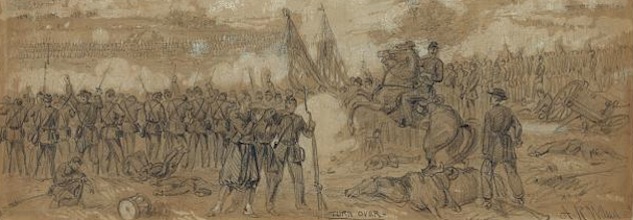Information about The Battle Of Seven Days, a Civil War Battle of the American Civil War

Battle Of Seven Days Facts
Location
Henrico County, Virginia
Dates
June 25 – July 1, 1862
Generals
Union: George B. McClellan
Confederate: Gen. Robert E. Lee
Soldiers Engaged
Union: 103,000
Confederate: 92,000
Important Events & Figures
Battle of Oak Grove
Battle of Mechanicsville
Battle of Gaines’ Mill
Battle of Garnett & Golding’s Farm
Battle of Savage Station
Battle of Glendale
Battle of Malvern Hill
Outcome
Confederate Victory
Seven Days Battle Casualties
Union: 15,500
Confederate: 20,000
Seven Days Battle
Seven Days Battle Summary: The Seven Days Battle or Seven Days Campaign took place from June 25 to July 1, 1862 and featured six different battles along the Virginia Peninsula east of Richmond. The Union Army of the Potomac, led by Maj. Gen. George B. McClellan, was over 100,000 men strong yet was steadily driven away from the ultimate goal of Richmond and back to the James River by Confederates led by a new field commander—Gen. Robert E. Lee.
Lee had been serving as military adviser to Confederate president Jefferson Davis, but when Gen. Joseph E. Johnston was wounded May 31 during the Battle of Seven Pines (Battle of Fair Oaks), Davis asked Lee to take command of the army in the field. Lee immediately set the men to work building defensive positions around Richmond, leading his grumbling soldiers to dub him “the Prince of Spades.” But Lee knew he could not protect the Confederate capital for long against such overwhelming odds. After Gen. Thomas J. “Stonewall” Jackson arrived with troops from the Shenandoah Valley Campaign, Lee prepared to strike McClellan’s Army.
McClellan struck first, sending two divisions of the III Corps to secure the Richmond & York River Railroad. The fighting on June 25 in the swamps around Oak Grove proved indecisive.
Lee took the initiative the next day, assaulting Federal positions along Beaver Dam Creek, north of the Chickahominy River. The plan depended on a rapid movement by Jackson’s tired men, who arrived too late. Major General A. P. Hill’s Confederate troops attacked as planned but were beaten back. However, the Federals, with Jackson on their right flank and Hill and Lt. Gen. James Longstreet to their front and left, fell back behind Boatswain Creek east of Gaines Mill.
On June 27, the Confederates attacked those positions in a series of costly charges. On the south side of the Chicahominy, a Confederate force from Maj. Gen. “Prince John” Magruder’s command attacked Federals at Garnett’s Farm but were repulsed. The savage attacks convinced the cautious McClellan that he needed to give up his plan to capture Richmond and fall back along his line of supply.
The 28th saw little fighting except for a failed Confederate reconnaissance attempt at Golding’s Farm. On June 29, Magruder struck the Union rear guard at Savage’s Station but with little effect.
On the 30th, three Confederate divisions hit Union positions in a battle known as Glendale or Frayser’s Farm. The Union division of Brig. Gen. George A. McCall routed, and their commander was captured, but counterattacks stopped the Rebel advance. Farther north, an assault by Jackson stalled in White Oak Swamp, and to the south, a half-hearted attempt by Maj. Gen. T. H. Holmes was turned back by Federal gunboats.
McClellan took up a strong defensive position on Malvern Hill a little north of the James River. Lee hammered the defenders with repeated assaults that cost the Confederate army 5,600 men but failed to carry the position. Strategically, however, Lee had won. McClellan retreated down the peninsula. Richmond was saved. Lee, whose reputation had previously suffered as a result of campaigns in Western Virginia over which he had little control, emerged as the Savior of the South. By August, he will have carried the fight back to Northern Virginia and, the following month, he and McClellan will clash again, this time along Antietam Creek outside Sharpsburg, Maryland.
Banner image Battle of Friday on the Chickahominy, created by Alfred Waud, Library of Congress.
